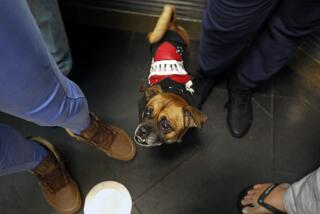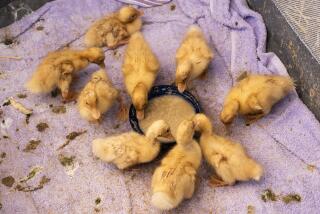For Love of a Dog, Billionaire Tries to Improve Pets’ Lives
- Share via
LAKE TAHOE — Before he built the massive stone and wood lodge on the edge of the lake, when he and his wife were living in a Walnut Creek, Calif., condo, David Duffield made a vow to a friend: “I promised her if we ever made some money, we would give it back.”
The friend, Maddie, is dead now. The miniature schnauzer’s ashes lie in a small cedar box in Duffield’s study. And Duffield, the founder of computer giant PeopleSoft Inc., now is worth somewhere between $1 billion and $2 billion.
So Duffield is keeping his promise, donating what is believed to be the largest single amount that the nation’s animal welfare community has ever received. He has given $200 million in stocks to Maddie’s Fund, a foundation named for the dog that Duffield and his wife, Cheryl, adored.
Established last year, the fund is dedicated to improving the lot of dogs and cats and to spreading the controversial gospel of “no kill,” an end to the nation’s routine euthanasia of millions of adoptable cats and dogs. Its endowment, which targets private nonprofit groups rather than government-run shelters, has drawn both plaudits and sniping. Duffield and the foundation have received letters from the public complaining that the riches are being lavished on animals rather than people. And some animal activists don’t like all the strings attached to Maddie grants and the fund’s no-kill emphasis.
“The animal welfare industry had gone on for decades doing the same thing,” observed Gary Templin, president of the Oakland Society for the Prevention of Cruelty to Animals. “[The fund] raises the ante of what our missions are . . . and it’s certainly created dialogue.”
Duffield, 59, who retired last year and hopes eventually to give the bulk of his fortune to the foundation, is unapologetic about his focus and his methods.
“I can’t tell you anything I would get more fulfillment out of than this particular area,” he said. “I feel for the homeless and people with disease, but I haven’t been touched by that.”
Like many software billionaires entering the world of philanthropy in recent years, he is ensuring that the foundation employs the same values of accountability and risk-taking that he used at his company, demanding novel approaches to saving the estimated 6 million to 8 million dogs and cats put to death each year in America’s shelters as well as tangible results.
*
Nonprofit groups have to go through an elaborate application process, promise to be nice to others in the field and report regularly, documenting that the number of cats and dogs euthanized in their communities is declining significantly.
Thus far the Alameda-based foundation has received well more than 1,000 applications and distributed almost $10 million, much of it in two multiyear grants. Of the grants to California operations, one is going to the California Veterinary Medical Assn. to spay and neuter feral cats, another to a Contra Costa County coalition that is offering low-cost spay and neutering services and promoting pet adoptions.
“We’re going to have to pick the places that make the biggest contribution. It’s a business,” Duffield said, sitting in the sun room of his lakefront home. The residence is so new, he actually has never sat on the couch before. The snow is blowing in horizontal sheets across the lake, shrinking his multimillion-dollar view into a few dozen yards of choppy waves.
Duffield talks of Maddie as he might a person.
The small dog with the big personality possessed a unique combination of qualities “that I really admired,” he said. She was smart, stubborn and affectionate, a great friend and source of comfort at a time when he and his wife were struggling to build their business software firm.
“I loved the heck out of the little thing,” he allowed, freely relating that the dog was a child substitute.
*
Duffield has three children, now grown, from his first marriage. He and Cheryl, who cannot bear children, have in recent years adopted a brood of five. The eldest is 6, the youngest a pair of 2-year-old identical twin girls who are so alike that Duffield has trouble telling them apart.
But the couple, now married 16 years, started with pets. First, there was a parakeet, then Peanut, a 16-year-old parrot that still lives with them. In the 1980s Maddie joined the fold.
They met her when she was a few days old and visited her regularly at the breeder’s kennel until she was weaned and could be taken home. She lived until 1997, when she developed cancer at the age of 10 and was put to sleep.
The Duffields’ animal family now consists of six birds and three dogs--a lanky German shepherd, a tiny Brussels griffon and Abigail, another schnauzer, who’s sweet but not as bright as Maddie, says Duffield. The birds listen to National Public Radio in their glass-walled aviary and the dogs have their own nanny-trainer.
“Probably one thing we could be criticized for,” Duffield admits, is that the dogs are purebred, not strays from a pound.
The couple created the Duffield Family Foundation in 1994 and gave away about $10 million to a variety of animal welfare causes. (Duffield’s philosophy on inheritance “is not to give children so much money they screw themselves up.”)
The foundation was reorganized into the more rigidly structured Maddie’s Fund early last year, and Richard Avanzino, president of the pioneering San Francisco SPCA, was hired to run it.
*
Avanzino, who helped make the San Francisco SPCA into the best-known no-kill shelter in the nation, is supplying much of the vision for Maddie’s Fund.
“We had the money. He had the experience,” Duffield noted.
In surveys, Avanzino said, the public typically refers to pets as best friends and family members.
“The American people are well ahead of [the shelter industry] and will demand nothing less” than no-kill, he argued. “A painless death is not an adequate answer for a healthy, loving, best friend.”
The no-kill movement has created a philosophical rift in the animal welfare world. Doubters call it a feel-good crusade that ignores reality: There are not enough homes for all the strays. No-kill shelters, they say, simply shift the dirty work of euthanasia to somebody else.
“We’re not trying to turn this country into a big San Francisco SPCA,” Duffield responded, adding that the animal welfare community should be more innovative and daring.
*
And Maddie’s Fund is turning heads.
“It’s like the 300-pound gorilla walking into the room,” said Geoffrey Simmons of the West Coast regional office of the Humane Society of the United States. “It’s got a lot of animal welfare organizations salivating.”
Most of the applications from as far away as Europe and Africa don’t comply with the organization’s detailed two-page grant guidelines.
The foundation won’t subsidize building projects or general operating budgets, instead seeking to support programs “that will successfully achieve the no-kill goal for their communities within five years” and to invest “in saving the lives of additional cats and dogs who would otherwise be killed.”
That disqualifies a lot of agencies.
“I guess our concern would be that the [type of] shelter that may need the additional funding the most” is not eligible, commented Martha Armstrong, a vice president of the Humane Society.
“It is by far the largest amount of money that has gone for animal protection,” she added. “And we applaud the Duffields for that. . . . We just are sorry about some of the limitations they’ve put” on the fund.
“We do have an agenda, and we’re not ashamed about it,” Avanzino said. “People can decide they want to join or not.”
More to Read
Inside the business of entertainment
The Wide Shot brings you news, analysis and insights on everything from streaming wars to production — and what it all means for the future.
You may occasionally receive promotional content from the Los Angeles Times.











